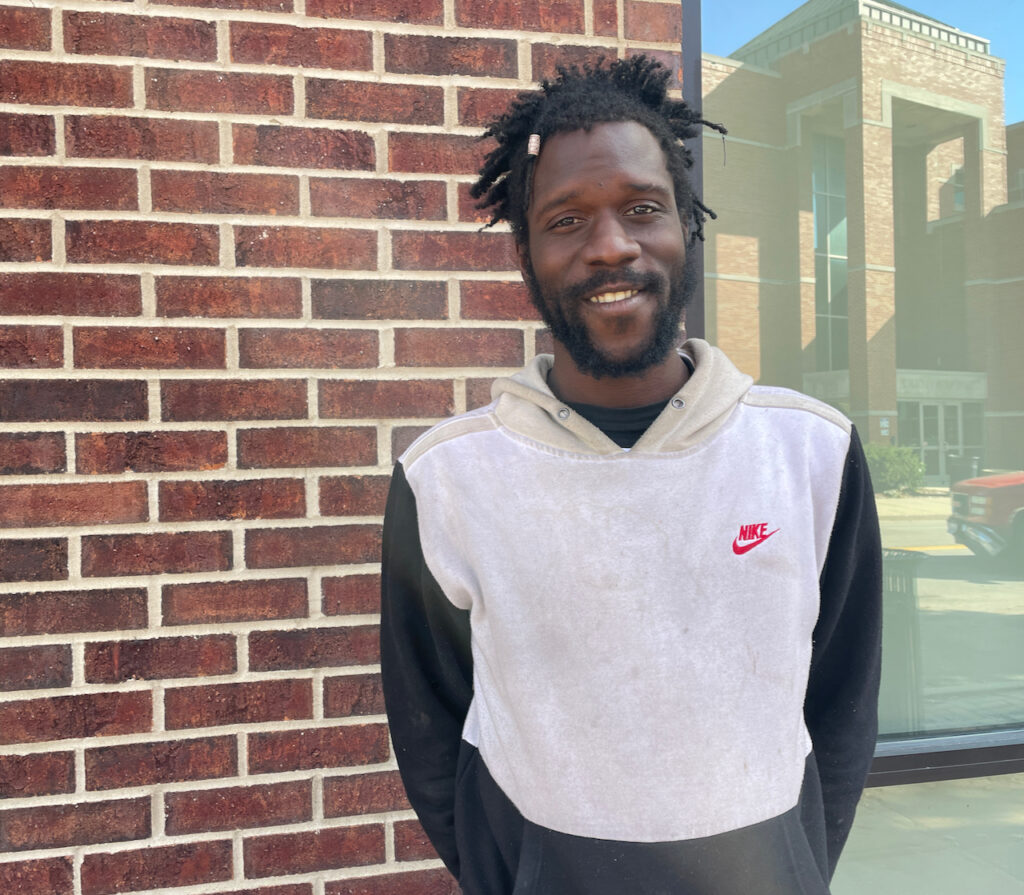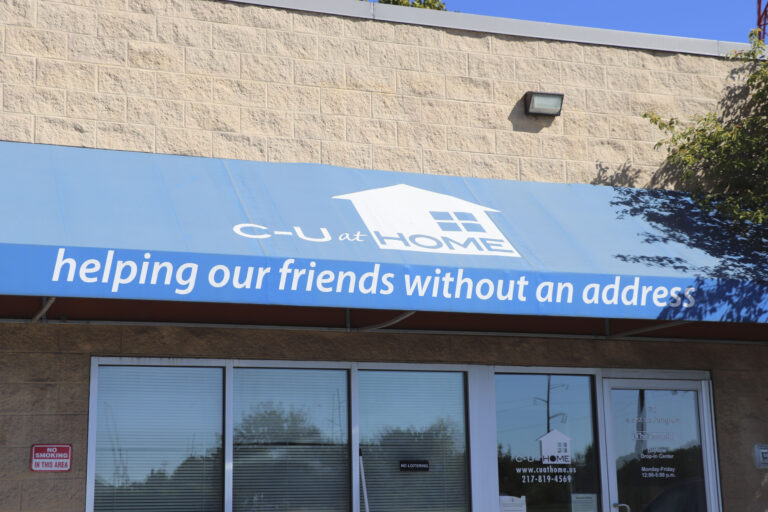CHAMPAIGN – Lined up shoulder to shoulder on an early November morning, volunteers prepared to hand out free mid-morning meals at the Daily Bread Soup Kitchen in Champaign.
Outside of the building stood a few guests waiting to pick up hot meals. These guests were people from around the community who struggle with food insecurity and sometimes homelessness. A speaker played upbeat music as people came and went.
Some guests came alone, some came with a companion, and others came with their kids.
Wearing a black-and-gray hoodie, Demond Reeves, one local homeless man, was one of these guests.
Reeves has been homeless for two years. Although he used to stay at C-U at Home, an existing shelter, he said he stopped going after it began drug testing its guests. He said he has been staying in a garage at a local restaurant.
“I’m a homeless person that literally lives outside because they have a drug test that they have, and it holds people like me from having somewhere to stay,” he said.
Reeves isn’t alone in this situation, and the city of Champaign knows it.
After spending more than $7 million on rent assistance and homelessness since the beginning of the pandemic, Champaign city officials are asking what else can be done to address homelessness in Champaign-Urbana.
For his part, Reeves said the city of Champaign needs a second shelter like Strides because drug tests create barriers that keep him and other people without homes from having a place to stay.
He said life has become more difficult ever since C-U at Home stopped letting him in because of his drug use.
“It made my life a lot harder,” he said. “I had to sleep outside of the shelter for a while.
In the summer, it’s alright. The winter sucks.”
Inside the Daily Bread Soup Kitchen, volunteers wore face masks and gloves as they scooped hot food into styrofoam to-go boxes before bringing them to the front of the store to be passed out to waiting guests.
In a cafeteria space meant to seat around 100 people, only three folding tables had been set up. Multiple stacks of chairs had been pushed up against the wall, unused.
Because of COVID-19, the kitchen hasn’t allowed guests inside for three years. Volunteer Charlie Evans said this limitation has had consequences for the kitchen’s mission in the community.
“Part of the mission – besides feeding people – was to provide a safe place for folks to come and sit and communicate,” Evans

said. “Because one of the aspects you see with homelessness, is there’s actually a lot of loneliness too.”
One part of the city’s plan to address homelessness, officials said, is to put nearly $4 million of that $7 million to the creation of a new homeless shelter, known as the Strides shelter.
City officials said the shelter’s goal is to create a safe sleeping space where people in need can receive services even if they are dealing with substance abuse or mental health problems. Strides will be located in C-U at Home’s current location of 70 E. Washington St. in Champaign.
Champaign’s Neighborhood Programs Manager Jennifer Carlson said this type of shelter is new to the community.
“Currently, in the single individual shelter world, people are packing up at 7 a.m., spending the day somewhere, and then coming back in the evening around 8 p.m. and sleeping overnight,” Carlson said. “With this new model, people will be able to stay 24/7.
“They won’t have to pack up and leave each day, so that in itself will be less of a disruption to their lives.”
But city officials said they know the addition of Strides isn’t enough to fully stop homelessness and housing insecurity.
The city of Champaign has received more than $25 million in COVID-19 relief funds since the start of the pandemic, according to Carlson.
She said most of the $7 million spent on homelessness came from these funds, which the city has used to help pay for rent and other housing needs.
But she said the money won’t last forever.
“We can develop great resources and support services for homelessness where we get people to a point where they move into permanent housing, but the long-term support needs might still be there,” she said.
Homelessness in Champaign County has been declining since 2014, according to a series of annual reports conducted by the Champaign County Continuum of Service Providers to the Homeless.
As of 2022, 137 people in Champaign County were identified as homeless, compared to 148 in 2021.
According to a report published by the U.S. Department of Housing and Urban Development, 326,000 people were living in emergency shelters, transitional housing or other temporary settings on a single night in 2021. This is an 8% decrease from 2020.
The department’s secretary, Marcia Fudge, said the report’s data indicates that the dispersal of federal COVID-19 relief funds had a positive effect on the reduced number of sheltered homeless people.
Yet she said the department’s mission isn’t over until the homelessness crisis ends.
Carlson said addressing homelessness goes beyond simply creating a homeless shelter.
“There’s so much more to it, right?” she said. “You need a full spectrum from that emergency shelter to the end with your permanent housing options.”
The pandemic also presented challenges for people without homes.
For Reeves, the homeless man who gets meals from the Daily Bread Soup Kitchen, catching COVID-19 at the beginning of this

year meant that he wasn’t able to enter any shelter spaces for two weeks.
“When I caught COVID, they definitely were not letting me into the shelter,” he said. “I had to stay outside the whole entire quarantine. The whole two weeks of quarantine, I was outside in the winter.”
Bailee VanAntwerp, Champaign Township’s Deputy Supervisor, said pandemic relief money let the Township broaden its emergency aid program so it could help people pay their water and electric bills.
“During COVID, I would say that it just helped them remain in a place in which they felt they could pay for their bills and not have to pick and choose over certain things,” VanAntwerp said.
The Township ran out of this additional funding over the summer. Without it, VanAntwerp says the Township is limited in its ability to help.
“Now, it’s to keep your housing because, during COVID, there was no evictions allowed for non-payment of rent,” she said.
Erik Lovell, an assistant professor of sociology at the University of Illinois Urbana campus who studies homelessness in Chicago, said homeless shelters are often a band-aid fix for a gushing wound.
“If we allow housing prices to skyrocket as they are doing – which has only gotten worse in the pandemic – and if we do not proactively increase minimum wages to keep up with it, then we’re gonna see homelessness for the rest of our lives,” he said.
By one calculation, in a family of two working adults and two children in Champaign County, each adult would need to earn $23.13 an hour to earn a living wage – or a wage that would let them afford adequate housing, food and other necessities.
For reference, the actual minimum wage is $12 an hour.
Lovell said getting someone into stable housing can be life-changing, yet homeless services often don’t have enough funding to push people into economic stability.
“It is so difficult in the current situation to have all the resources and time needed to really help someone move from poverty into economic stability,” he said.
However, he said shelters save lives by keeping people off the streets.
“They do save lives, and that’s very important and something we need,” Lovell said. “I just don’t think they are well-resourced or well-equipped enough to actually push people from this cycle into long-term economic stability. Not because they’re not good at what they do, but because they’re strapped for resources.”
After multiple delays, shelter organizers said they hope to have their new facility open by December 12.

